#schiller duval
Explore tagged Tumblr posts
Text

Not going to even front. I loved this show as a kid and watched every episode. It was called "the most repulsive concept ever for television" when Roy Huggins pitched it to ABC in 1960, until Leonard Goldenson of ABC called it the best idea he'd ever heard. Such summarizes the huge effort Roy Huggins invested to get The Fugitive to television. Teaming with producer Quinn Martin, Huggins' concept was made flesh with the casting of David Janssen as Dr. Richard Kimble and British-born Canadian Barry Morse as his nemesis, Lt. Philip Gerard. Huggins and Martin worked to make a compelling weekly drama via superb scripts, top-notch guest casts, narrator William Conrad, and enticing music by Peter Rugolo, and succeeded perhaps more than they ever dared to hope. The Fugitive remains compelling television years later. Janssen and Morse imbue tremendous sympathy into their roles and make their characters so compelling that audiences even went too far, assailing Morse by saying, "You dumb cop, don't you realize he's innocent?" It even extended to the one-armed vagrant who was key to the drama, played by stuntman Bill Raisch, who in one incident was even picked up by the real LAPD because they thought he was "wanted for something," before they realized he was just an actor. If The Fugitive had a drawback, it was because it worked too well - it is emotionally draining watching the show because the sympathy enticed for the characters is so great that seeing them suffer is painful, such as in the two-part episode "Never Wave Goodbye" - the audience is put through the emotional wringer every bit as much as Kimble, Gerard, and the story's supporting players (in this case played by Susan Oliver, Will Kuliva, Robert Duvall, and Lee Phillips).
The series was shot in black and white in its first three seasons, but for the fourth season came the replacement of producer Alan Armer with Wilton Schiller and the switch to color. The quality of the series remained high, but it is a measure of the show's quality that early fourth-season episodes are considered disappointing, and yet are still excellent stories with genuine emotional pull. The fourth-season settled down when writer-producer George Eckstein was brought in early on to help out Schiller, and it helped bring about some of the series' best moments, notably in the episode "The Ivy Maze," where for the first time in the series, all three protagonists (Kimble, Gerard, and Fred Johnson, the one-armed man) confront each other. The performances and all else within made The Fugitive TV's most compelling drama, then and forever. The 120 episodes (90 in B&W, 30 in Color) of the television drama "The Fugitive" originally ran from 1963-1967 on ABC. The broadcast of the final episodes in August 1967 was a national event.
0 notes
Text
Choriocarcinoma typically affects younger men in the age range of 15 to 35-years-old. These tumors are associated with the development of gynecomastia due to the secretion of beta human chorionic gonadotropin, which has similar properties to luteinizing hormone. Patients can present with precocious puberty, gynecomastia, impotence, or loss of libido. Histologically, a choriocarcinoma will show the presence of both syncytiotrophoblastic cells and cytotrophoblastic cells.
Sertoli cell tumors are derived from the cells located within the seminiferous tubules, and can occur in both children and in middle-aged adults. Histology will reveal uniform tall polyhedral cells that are arranged in sheets and cords that resemble spermatic tubules. The presence of perinuclear aggregates of intermediate filaments is pathognomonic of a Sertoli cell tumor. Inhibin-alpha is a tumor marker.
Yolk sac tumor is the most common testicular neoplasm in infants, with an average age of diagnosis between 1 to 2-years-old. Children with yolk sac tumors usually present with a painless testicular mass. Histologically, the presence of Schiller-Duval bodies is pathognomonic of yolk sac tumors. Schiller-Duval bodies contain a central vessel that is surrounded by flattened tumor cells in a cystic space. The tumor marker for yolk sac tumor is alpha-fetoprotein.
A histological examination of Leydig cell tumors will reveal the presence of Reinke’s crystals in the interstitial cells of the testis. Reinke’s crystals are rod-shaped intracytoplasmic crystal-like inclusions with rounded ends.
#choriocarcinoma#germ cell tumors#sertoli cell tumor#sertoli cell#af photography#schiller duval#schiller duval body#yolk sac tumor#Reinke#Reinke crystal#Reinke crystals#Leydig cell tumor#Leydig cell
2 notes
·
View notes
Text
Authors of Source Materials of Verdi Operas, Ranked by How Many Times Verdi Used Their Work As Source Material:
(we’re going with the main 26)
Friedrich Schiller: 4 (Giovanna d’Arco, I masnadieri, Luisa Miller, Don Carlos)
*a fifth opera, La forza del destino, interpolates a scene from another Schiller play, although the larger work is not based on Schiller
William Shakespeare: 3 (Macbeth, Otello, Falstaff)
Lord Byron: 2 (I due Foscari, Il corsaro)
Antonio García Gutiérrez: 2 (Il trovatore, Simon Boccanegra)
Victor Hugo: 2 (Ernani, Rigoletto)
Augustin-Eugène Scribe: 2 (Les vêpres siciliennes, Un ballo in maschera)
*Charles Duveyrier collaborated with Scribe on the source material for Vêpres but not Ballo
Indirect collaboration between Auguste Anicet-Bourgeois, Francis Cornu, and Antonio Cortese: 1 (Nabucco)
Collaboration between Eugène Bourgeois and Émile Souvestre: 1 (Stiffelio)
Alexandre Dumas, fils: 1 (La traviata)
Alexandre-Vincent Pineux Duval: 1 (Un giorno di regno)
Tommaso Grossi: 1 (I Lombardi alla prima crociata)
Disputed between Auguste Mariette and Temistocle Solera: 1 (Aida)
Joseph Méry: 1 (La battaglia di Legnano)
*he also co-wrote the libretto for Don Carlos but that’s not the source material so it doesn’t count
Antonio Piazza: 1 (Oberto, conte di San Bonifacio)
Ángel de Saavedra: 1 (La forza del destino)
*see additional note under Schiller
Voltaire: 1 (Alzira)
Zacharias Werner: 1 (Attila)
12 notes
·
View notes
Text
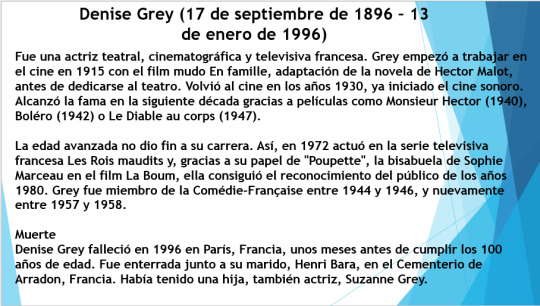
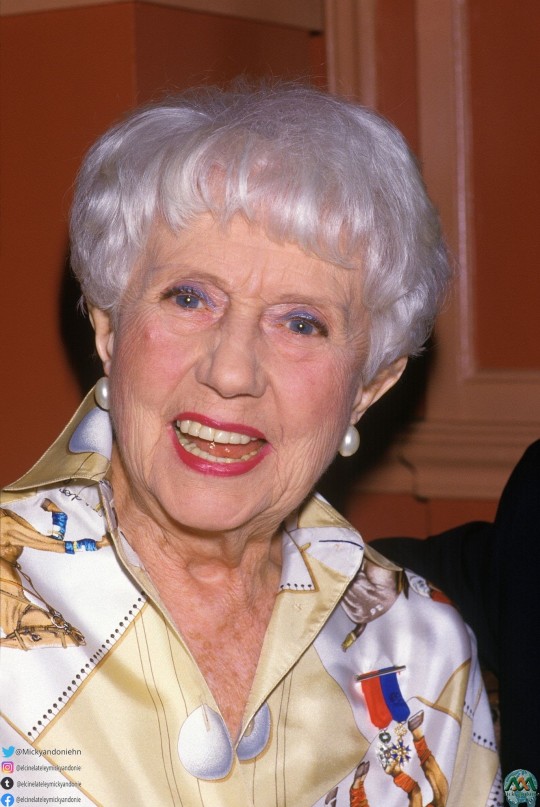
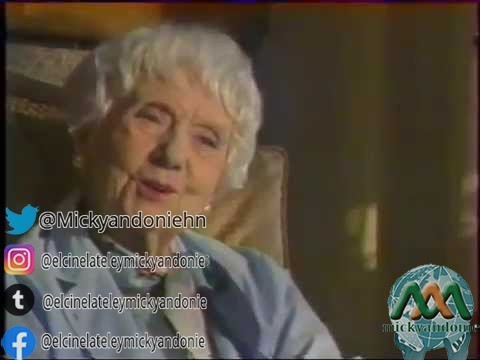
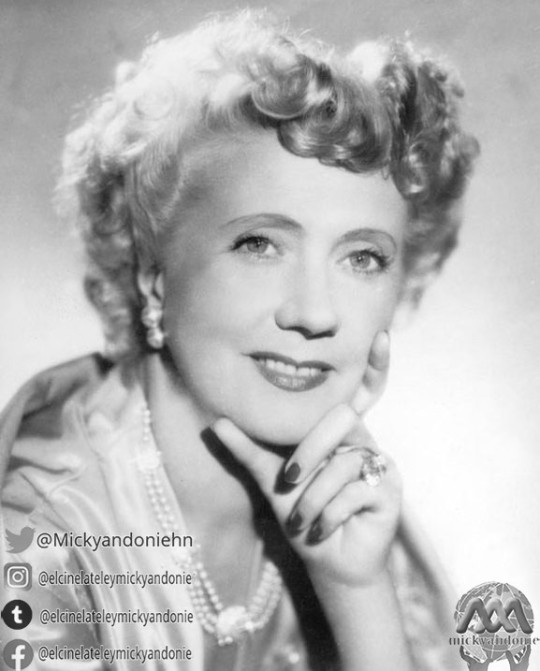
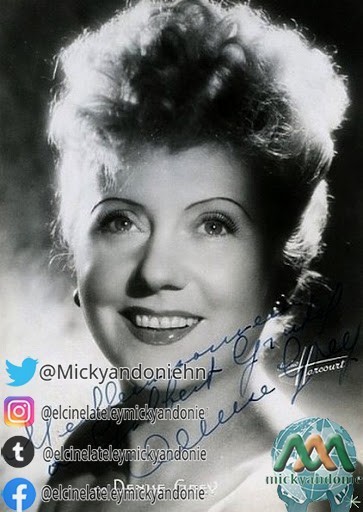
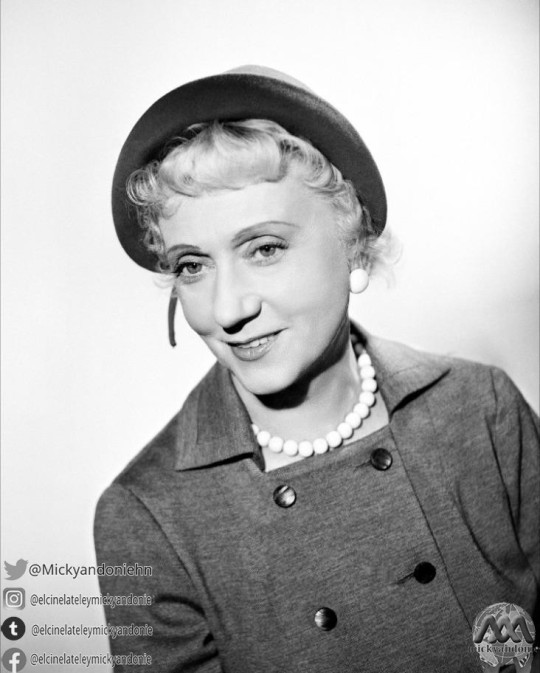
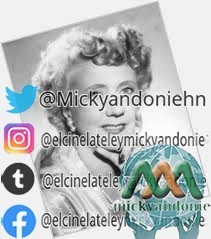
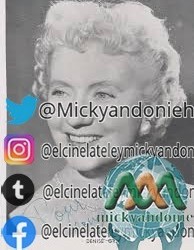

Denise Grey.
Filmografía
Cine
1913 : Mademoiselle Etchiko
1914 : En famille, de Georges Monca
1914 : Madame Rigadin, modiste, de Georges Monca
1914 : Mademoiselle Etchiko, de André Hugon
1914 : Le Voyage de Corbillon, de Georges Monca
1916 : Document secret, de René Navarre
1916 : Nemrod et Cie, de Maurice Mariaud
1916 : Rigadin professeur de danse, de Georges Monca
1917 : Les Bleus de l'amour, de Henri Desfontaines
1917 : Honneur d'artiste, de Jean Kemm
1935 : Jeunes Filles à marier, de Jean Vallée
1936 : La Dame de Vittel, de Roger Goupillières
1937 : Trois artilleurs au pensionnat, de René Pujol
1938 : Trois artilleurs à l'opéra, de André Chotin
1938 : Serge Panine, de Paul Schiller y Charles Méré
1940 : Monsieur Hector, de Maurice Cammage
1941 : Boléro, de Jean Boyer
1941 : Montmartre-sur-Seine, de Georges Lacombe
1942 : Romance à trois, de Roger Richebé
1942 : Le Voile bleu, de Jean Stelli
1942 : Des jeunes filles dans la nuit, de René Le Hénaff
1942 : Retour de flamme, de Henri Fescourt
1942 : L'Honorable Catherine, de Marcel L'Herbier
1943 : Adieu Léonard, de Pierre Prévert
1943 : Vingt-cinq ans de bonheur, de René Jayet
1943 : L'aventure est au coin de la rue, de Jacques Daniel-Norman
1944 : Les Caves du Majestic, de Richard Pottier
1945 : On demande un ménage, de Maurice Cam
1945 : Madame et son flirt de Jean de Marguenat
1945 : L'Insaisissable Frédéric, de Richard Pottier
1945 : L'Extravagante Mission, de Henri Calef
1946 : Étrange Destin, de Louis Cuny
1946 : Le Couple idéal, de Bernard Roland y Raymond Rouleau
1946 : Six heures à perdre, de Alex Joffé y Jean Lévitte
1946 : Coïncidences, de Serge Debecque
1946 : Le Diable au corps, de Claude Autant-Lara
1947 : Et dix de der, de Robert Hennion
1947 : Carré de valets, de André Berthomieu
1948 : Une femme par jour, de Jean Boyer
1948 : Bonheur en location, de Jean Wall
1949 : La Ronde des heures, de Alexandre Ryder
1949 : Tête blonde, de Maurice Cam
1949 : Mon ami Sainfoin, de Marc-Gilbert Sauvajon
1949 : Pas de week-end pour notre amour, de Pierre Montazel
1950 : Rome-Express, de Christian Stengel
1950 : Les Petites Cardinal, de Gilles Grangier
1950 : Demain nous divorçons, de Louis Cuny
1952 : Allô... je t'aime.
1952 : La Tournée des grands ducs, de André Pellenc
1953 : Art. 519 Codice Penale, de Leonardo Cortese
1953 : Il Seduttore, de Franco Rossi
1953 : Raspoutine, de Georges Combret
1953 : Dortoir des grandes, de Henri Decoin
1953 : Les Corsaires du bois de Boulogne, de Norbert Carbonnaux
1953 : Julietta, de Marc Allégret
1953 : Le Père de Mademoiselle, de Marcel L'Herbier
1954 : Escalier de service, de Carlo Rim, sketch Les Béchard
1954 : Le Printemps, l'automne et l'amour, de Gilles Grangier
1954 : Fantaisie d'un jour, de Pierre Cardinal
1954 : Le Mouton à cinq pattes, de Henri Verneuil
1954 : Poisson d'avril, de Gilles Grangier
1955 : La Villa Sans-Souci, de Maurice Labro
1955 : La Rue des bouches peintes, de Robert Vernay
1956 : Sylviane de mes nuits, de Marcel Blistène
1956 : L'Auberge fleurie, de Pierre Chevalier
1956 : Une nuit aux Baléares, de Paul Mesnier
1956 : Mitsou, de Jacqueline Audry
1957 : À pied, à cheval et en voiture, de Maurice Delbez
1957 : Carve Her Name with Pride, de Lewis Gilbert
1957 : La Peau de l'ours, de Claude Boissol
1957 : Le Tombeur, de René Delacroix
1957 : Police judiciaire, de Maurice de Canonge
1957 : Mimi Pinson, de Robert Darène
1957 : C'est la faute d'Adam, de Jacqueline Audry
1958 : À pied, à cheval et en spoutnik, de Jean Dréville
1959 : Bomben im Monte-Carlo, de Georg Jacoby
1959 : Le Confident de ces dames, de Jean Boyer
1960 : Le Panier à crabes, de Joseph Lisbona
1960 : La Française et l'Amour, de Christian-Jaque, sketch Le Divorce
1963 : La Bonne Soupe, de Robert Thomas
1965 : Pas de caviar pour tante Olga, de Jean Becker
1969 : La Maison de campagne, de Jean Girault
1970 : Hello-Goodbye, de Jean Negulesco
1970 : Los Aristogatos, de The Walt Disney Company
1971 : Mais qui donc m'a fait ce bébé ?, de Michel Gérard
1980 : La Boum, de Claude Pinoteau
1982 : La Boum 2, de Claude Pinoteau
1982 : N'oublie pas ton père au vestiaire..., de Richard Balducci
1982 : En cas de guerre mondiale, je file à l'étranger, de Jacques Ardouin
1983 : Le Voleur de feuilles, de Pierre Trabaud
1985 : Le Gaffeur, de Serge Pénard
1988 : Les Saisons du plaisir, de Jean-Pierre Mocky
1991 : Tchin tchin, de Gene Saks.
Televisión
1960 : Rouge, de André Leroux
1962 : Chéri
1967 : Le Chevalier Tempête, de Yannick Andréi
1969 : Tout pour le mieux
1971 : Une autre vie
1972 : Les Rois maudits, de Marcel Jullian y Claude Barma
1977 y 1982 : Cinéma 16
1978 : Un ours pas comme les autres
1979 : Les Moyens du bord
1979 : Les Dames de la côte, de Nina Companeez
1980 : L'Esprit de famille
1983 : Merci Sylvestre
1985 : Les temps difficiles.
Teatro
1916 : Six Hommes, une femme et un singe, de Pierre Veber y Yves Mirande, Théâtre Michel
1921 : Comédienne, de Jacques Bousquet y Paul Armont, Théâtre des Nouveautés
1922 : La Femme de mon ami, Théâtre de l'Athénée
1922 : Atout... Cœur !, de Félix Gandéra, Théâtre de l'Athénée
1924 : Si je voulais..., de Paul Géraldy y Robert Spitzer, Théâtre du Gymnase Marie-Bell
1926 : Passionnément, de Maurice Hennequin y Albert Willemetz, Théâtre de la Michodière
1936 : Europe, de Maurice Rostand, Théâtre Pigalle
1938 : Le Valet maître, de Paul Armont y Léopold Marchand, escenografía de Pierre Fresnay, Théâtre de la Michodière
1948 : Les Enfants d'Edouard, de Frederic Jackson y Roland Bottomley, adaptación de Marc-Gilbert Sauvajon, escenografía de Jean Wall, Théâtre Édouard VII
1949 : Les Enfants d'Edouard, de Frederic Jackson y Roland Bottomley, adaptación de Marc-Gilbert Sauvajon, escenografía de Jean Wall, Théâtre des Célestins
1950 : George et Margaret, de Marc-Gilbert Sauvajon y Jean Wall, escenografía de Jean Wall, Théâtre Daunou
1950 : Il faut marier maman, de Marc-Cab y Serge Veber, escenografía de Pierre Dux, Théâtre de Paris
1953 : Faites-moi confiance, de Michel Duran, escenografía de Jean Meyer, Théâtre du Gymnase Marie-Bell
1955 : Les Enfants d'Edouard, de Frederic Jackson y Roland Bottomley, adaptación de Marc-Gilbert Sauvajon, escenografía de Jean Wall, Théâtre des Célestins
1956 : La Femme du siècle, de Claude Schnerb, escenografía de Jacques-Henri Duval, Théâtre des Célestins, giras Georges Herbert
1959 : Bon Week-End Mr. Bennett, de Paule de Beaumont a partir de Arthur Watkyn, escenografía de Michel Vitold, Théâtre de la Gaîté-Montparnasse
1961 : Ocho mujeres, de Robert Thomas escenografía de Jean Le Poulai.
1962 : Ocho mujeres, de Robert Thomas, escenografía de Jean Le Poulain, Théâtre des Bouffes-Parisiens
1963 : Vénus de Milo, de Jacques Deval, escenografía de Pierre Mondy, Théâtre des Célestins
1965 : Assassins associés, de Robert Thomas, escenografía de Jean Piat, Théâtre Antoine y Théâtre du Palais-Royal
1966 : J'y suis, j'y reste, de Jean Valmy y Raymond Vincy, escenografía de Jean Valmy, Théâtre Marigny
1966 : La Fin du monde, de Sacha Guitry, escenografía de Jean-Pierre Delage, Théâtre de la Madeleine
1967 : Quarante Carats, de Pierre Barillet y Jean-Pierre Gredy, escenografía de Jacques Charon, Théâtre de la Madeleine
1971 : Le Train de l'aube, de Tennessee Williams, escenografía de Jean-Pierre Laruy, Théâtre Édouard VII
1972 : En avant... toute !, de Michel André, escenografía de Michel Roux, Théâtre Édouard VII
1972 : La Bonne Adresse, de Marc Camoletti, escenografía de Christian-Gérard, Théâtre Michel
1973 : La Royale Performance, de Marcel Mithois, escenografía de Jean-Pierre Delage, Théâtre des Bouffes-Parisiens
1974 : Le Tube, de Françoise Dorin, escenografía de François Périer, Théâtre Antoine
1976 : Le Jardin de craie, de Enid Bagnold, escenografía de Raymond Gérôme, Théâtre Hébertot
1977 : Bichon, de Jean de Létraz, escenografía de Jacques Valois, Théâtre de Charleville-Mézières
1978 : Crime à la clef, de Alain Bernier y Roger Maridat, escenografía de Jean-Paul Cisife, Théâtre Tristan-Bernard
1981 : La vie est trop courte, de André Roussin, escenografía de Michel Fagadau, Théâtre Daunou
1983 : La vie est trop courte, de André Roussin, escenografía de Michel Fagadau, Théâtre de la Gaîté-Montparnasse
1984-1985 : Les Temps difficiles, de Édouard Bourdet, escenografía de Pierre Dux, Théâtre des Variétés
1985 : Harold et Maude, de Colin Higgins, escenografía de Jean-Luc Tardieu, Espace 44 Nantes
1987 : Harold et Maude, de Colin Higgins, escenografía de Jean-Luc Tardieu, Théâtre Antoine
1989 : Arsénico y encaje antiguo, de Joseph Kesselring, escenografía de Jean-Luc Tardieu, gira
1991 : La sopera, de Robert Lamoureux, escenografía de François Joffo.
Operetas
1919 : Nelly, de Marcel Lattès, con Félix Oudart (Théâtre de la Gaîté)
1950 : Il faut marier maman, de Guy Lafarge, Théâtre de Paris, con Roland Armontel.
Créditos: Tomado de Wikipedia
https://es.wikipedia.org/wiki/Denise_Grey
#HONDURASQUEDATEENCASA
#ELCINELATELEYMICKYANDONIE
5 notes
·
View notes
Text
Reproductive medicine and Surgery and Gynae oncology Neet SS

A very special branch and nowadays much sought out branch. Many new Mch aspirants want to have super specialization in Reproductive medicine and Surgery and Gynae oncology.
NEET SS test series is a super specialization exam. It is conducted as an online exam now.
The pattern of exams has also changed and Mch aspirants need to be specific as what to study.
Mch is related to surgical Specialities. Mch Reproductive medicine and Surgery and Gynae oncology are new upcoming and very exciting branches and some Hospitals and Medical Colleges are coming up with Super specialization in these fields although the number of seats is not that big. These branches are gaining Scope.
NBE Changed the pattern to online exams as CBT exam. The Mch exams as a whole are now conducted as online MCQ Based exam.
Details of Mch Reproductive medicine and Surgery and Gynae oncology
Examination
Exam: Neet ss Reproductive medicine and Surgery and Gynae oncology.
§ Conducted by : NBE
§ Eligibility: MS Surgery
§ Level: Pg Superspeciality
§ Duration: 3 years
§ Probable Upcoming Dates: September/October or Beyond
§ Question Type : MCQs
§ Exam : Single Day Online Examination
Mch aspirants are always in search of what to study and what is asked in Mch exams. Our Experts found that a great depth of basic facts and profound knowledge of Anatomy, surgical anatomy, embryology is needed as students are tested on the basics as well.
So what to Study for Neet ss Reproductive medicine and Surgery and Gynae oncology.
A Mch Aspirant should be well versed with Surgical Anatomy and especially embryology. Some topics asked in last few examinations are about :
§ Primordial Germ cell
§ Coelomic epithelium
§ Genital ridge mesenchyme
§ Mesonephric tubules
§ Mesonephric duct (wolfian duct)
§ Paramesonephric duct(Mullerian duct)
§ Genital tubercle
§ Urogenital folds
§ Labioscrotal swellings
§ Urogenital sinus
A Mch Aspirant should be well versed with Defects which are examiners favorite. Top on mind of examiners are:
· Bicornuate uterus
· Arcuate uterus
· Uterus didelphys
· Complete septum
· Unicornuate uterus
· Mullerian agenesis
For Mch Gynae Oncology it is important to know about topics especially listed below. These topics should be studied in full detail from all available standard text books.
§ Arrhenoblastoma
§ Call –Exner bodies
§ Endometrial stromal sarcoma
§ Carcinosarcoma
§ Leiomyosarcomas
§ Granulosa cell tumour
§ Sertoli-Leydig cell tumour
§ Hilar cell tumour
§ Renkies Crystals
§ Thecoma
§ Krukenbergs tumour
§ Lipoid cell tumour
§ Signet Ring cells
§ Endodermal Sinus tumour
§ Schiller Duval bodies
§ Psammoma Bodies
§ Serous tumours
§ Fibroma
§ Meigs Syndrome
§ Brenner tumour
§ Pseudomeigs Syndrome
§ Estrogen- producing
§ Granulosa cell tumour
§ Carcinoid(Seratonin- producing)
§ Thyroid tumour(Struma Ovarii)
§ Choriocarcinoma of the ovary
For Mch Neet ss Reproductive medicine and Surgery and Gynae Oncology it is important to know about topics especially listed below. Our experts and NEET SS Students should be able to differentiate between different types of masses.
§ Follicle Cysts
§ Corpus luteum cysts
§ Theca lutein cysts
§ Inflammatory(T.O.abscess)
§ Endometritic Cysts
§ Benign teratoma(dermoid cysts)
§ Malignant teratoma
Use of Drugs is very important. Various questions in Reproductive medicine and Surgery on Drugs, their doses, use and side effects have been asked in recent Neet ss exams. Notably students should have knowledge about drugs like
§ Progestogens
§ Androgens
§ Danazol
§ GnRH analogues
§ Clomiphene
§ Metformin
§ OCPS
§ Barrier devices
§ Male contraceptives
Use of Drugs is very important. Various questions in Gynaeoncology on Drugs, their doses, use and side effects have been asked in recent Neet ss exams. Notably students should have knowledge about drugs like
§ Abagovomab
§ Aminoglutethirnide
§ Busurelin
§ Cetorelix
§ Cisplatin
§ Diethyistilbesterol
§ Ertumaxomab
§ Ethinyl estradiol
§ Flutamide
§ Formestane
§ Ganirelix
§ Goserelin
§ Letrozole
§ Leuprolide
§ Medroxyprogesterone acetate
§ Methotrexate
§ Nafarelin
§ Tamoxifen
§ Doloxifen
§ Trastuzumab
§ Vorozole
What is important and frequently asked in reproductive medicine is about topics below. They need to be studied in detail .
§ Adenoma(Prolactinoma)
§ Sheehans syndrome
§ Simmonds disease
§ Premature Thelarche
§ Premature Puberche
§ Premature Menarche
Important Surgeries which are frequently in examiners mind.
§ Boari Flap Technique
§ BSO
§ Chassar Moir Technique
§ Conisation
§ Cryotherapy
§ Hysterectomy
§ IVF Techniques
§ Laser Ablation or vaporization
§ LEEP
§ Mc Donald/Shirodkar Cerciage
§ Omentectomy
§ Straussman Unification Surgery
§ TAH
In Reproductive medicine Even Expect Questions on Basic Topics like
§ Barrier method
§ Natural contraception
§ Oral contraceptive pill
§ Injectables
§ Implants
§ Nova T/Multiload 375/Levonova
§ CuT 380 A
§ Progestasert
§ CuT 200B
§ Levonorgestrel containing IUCD
We would stress the need to focus on basics. It is important to know physiology and biochemistry about important hormones such as below. Lots of questions are asked on these topics.
§ Human chorionic Gonadotrophin(HCG)
§ Human Placental Lactogen(HPL)
§ Human Chorionic Thyrotrophin(HCT)
§ Human Chorionic Corticotrophin(HCC)
§ Pregnancy specific Beta-1 Glycoprotein
§ Estriol
§ Estradiol
§ Estrone
§ Progesterone
A detailed knowledge in Oncology is tested about cancers of genitalia especially.
This forms a large chunk of questions and no one can afford to miss them. Questions on subtypes are also asked minutely.
§ Cervix Cancer
§ Fallopian tubes Cancer
§ Breast Cancer
§ Ovarian Cancers
§ Endometrial Cancers
§ Premalignant Lesions
§ Carcinoma in Situ
§ HPV Strains
§ Lynch type II syndrome
§ Non polyposis coli
§ Familial inheritance of cancer ovary
§ Familial breast, ovarian cancer
§ Premalignant lesion of cancer cervix
§ Dysplasia
§ CIN I LSIL
§ CIN II HSIL
§ CIN III HSIL
§ Ca in situ HSIL
§ Invasive cancer
These Topics are asked in detail.
Mch Aspirants for Neet ss mock test Reproductive medicine and Surgery and Gynae oncology should start well in time and be regular in studies in addition to practicing as any Mcqs as possible. Online tests are of greatest value .Standard text books for all important topics are a must.
0 notes
Text
Racing is Back!
This weekend is North America’s auto racing’s groundhog day. The WeatherTech SportsCar Championship season kicks off with the Rolex 24 this weekend marking the official start of the 2019 racing season. Yeah, so we’re super excited, just as you should be.
Below is the broadcast schedule and some potential highlights of this year’s event.
Broad Casts Schedule (All times Pacific)
SATURDAY, JAN. 26
-- IMSA WeatherTech SportsCar Championship 2019 Rolex 24 Preview Show, Daytona Beach, Fla.; 10 p.m., NBCSN (T)
-- IMSA WeatherTech SportsCar Championship Rolex 24 at Daytona, Daytona Beach, Fla.; 11a.m.-5 p.m., NBCSN (L)
-- IMSA WeatherTech SportsCar Championship Rolex 24 at Daytona, Daytona Beach, Fla.;11:25a.m-8:55 p.m., IMSA.tv (L)
-- IMSA WeatherTech SportsCar Championship Rolex 24 at Daytona, Daytona Beach, Fla.; 3-6p.m., NBC Sports app (L)
-- IMSA WeatherTech SportsCar Championship Rolex 24 at Daytona, Daytona Beach, Fla.; 9 p.m.-3 a.m., NBCSN (L)
SUNDAY, JAN. 27
-- IMSA WeatherTech SportsCar Championship Rolex 24 at Daytona, Daytona Beach, Fla.; midnight-11:35 a.m., IMSA.tv (L)
-- IMSA WeatherTech SportsCar Championship Rolex 24 at Daytona, Daytona Beach, Fla.; 12 a.m.-3 a.m., NBC Sports app (L)
-- IMSA WeatherTech SportsCar Championship Rolex 24 at Daytona, Daytona Beach, Fla.; 3 a.m.-12 p.m., NBCSN (L)
L = live, S = same day, taped, T = tape delay
IMSA.tv = online
*All times Eastern
Story Lines:
Fast Freddie:
Two time Formula 1 Champion Fernando Alonso joins with the Wayne Taylor Racing Cadillac DPi-V.r with fellow former F1 driver Kamui Kobyashi and WTR full season drivers Jordan Taylor and Renger van der Zande. This is the second Daytona 24 for Alonso.
Zanardi:
A legend returns to North America. Overshadowing Alonso is the return of Alex Zanardi to headline his first North American race since he lost both his legs in a crash in 2001. Zanardi’s car uses a steering wheel with hand levers to control throttle and braking on his Team RLL #24 BMW M8 GTE. All Female Team:
Meyer Shank Racing will field the #57 Acura NSX GT3 with an all female driver lineup made up of Katherine Legge, Simona De Silvestro, Bia Figueiredo and Christina Nielsen. Legge will continue with the Meyer Shank team for the remainder of the WeatherTech season.
Joest Do It:
The 2019 Daytona 24 Hours marks 40 years since Mazda debuted at Daytona, a race they won the first time out. The Mazda Team Joest entries look strong this year as Oliver Jarvis claimed the first pole position (1m33.685s) for the Mazda Daytona Prototype since it entered the WeatherTech SportsCar Championship. Jarvis's time was the fastest ever sportscar lap around the Daytona International Speedway, eclipsing the 1m33.875s record set by PJ Jones in an Eagle-Toyota MkIII in 1993. This could be the start of Joest dominance that hasn’t occurred since the Audi Team Joest dominated sports car racing in the 2000s.
Complete Entry List:
Daytona Prototype International (DPi) – 11 entries
#5 Mustang Sampling Racing Cadillac DPi (Barbosa/Conway/Albuquerque/Fittipaldi) #6 Acura Team Penske Acura DPi (Montoya/Cameron/Pagenaud) #7 Acura Team Penske Acura DPi (Taylor/Castroneves/Rossi) #10 Konica Minolta Cadillac DPi (van der Zande/Taylor/Alonso/Kobayashi) #31 Whelen Engineering Racing Cadillac DPi (Nasr/Curran/Derani) #50 Juncos Racing Cadillac DPi (Owen/Binder/Cannapino/Kaiser) #54 CORE Autosport Nissan DPi (Bennett/Braun/Dumas/Duval) #55 Mazda Team Joest Mazda DPi (Bomarito/Tincknell/Pla) #77 Mazda Team Joest Mazda DPi (Jarvis/Nunez/Bernhard/Rast) #84 JDC-Miller Motorsports Cadillac DPi (Trummer/Simpson/Miller/Piedrahita) #85 JDC-Miller Motorsports Cadillac DPi (Goikhberg/Vautier/DeFrancesco/Barrichello)
Le Mans Prototype 2 (LMP2) – 4 entries
#18 DragonSpeed Oreca 07 Gibson (Gonzalez/Maldonado/Saavedra/Cullen) #38 Performance Tech Motorsports Oreca 07 Gibson (K Masson/R Masson/Cassels/Wright) #52 PR1 Mathiasen Motorsports Oreca 07 Gibson (McMurry/Aubry/Kvamme/Guibbert) #81 DragonSpeed Oreca 07 Gibson (Hedman/Hanley/Lapierre/Allen)
GT Le Mans (GTLM) – 9 entries
#3 Corvette Racing Corvette C7.R (Magnussen/Garcia/Rockenfeller) #4 Corvette Racing Corvette C7.R (Gavin/Milner/Fassler) #24 BMW Team RLL BMW M8 GTE (Krohn/Edwards/Mostert/Zanardi) #25 BMW Team RLL BMW M8 GTE (Farfus/De Phillippi/Eng/Herta) #62 Risi Competizione Ferrari 488 GTE (Rigon/Molina/Pier Guidi/Calado) #66 Ford Chip Ganassi Racing Ford GT (Hand/Muller/Bourdais) #67 Ford Chip Ganassi Racing Ford GT (Briscoe/Westbrook/Dixon) #911 Porsche GT Team Porsche 911 RSR (Pilet/Tandy/Makowiecki) #912 Porsche GT Team Porsche 911 RSR (Bamber/Vanthoor/Jaminet)
GT Daytona (GTD) – 23 entries
#8 Starworks Motorsport Audi R8 LMS GT3 (Chase/Dalziel/Perez Companc/Haase) #9 PFAFF Motorsports Porsche 911 GT3 R (Hargrove/Robichon/Kern/Olsen) #11 Grasser Racing Team Lamborghini Huracan GT3 (Ineichen/Bortolotti/Engelhart/Breukers) #12 AIM Vasser Sullivan Lexus RC F GT3 (Montecalvo/Bell/Telitz/Segal) #13 Via Italia Racing Ferrari 488 GT3 (Longo/Franzoni/Gomes/Bertolini) #14 AIM Vasser Sullivan Lexus RC F GT3 (Heistand/Hawksworth/Cindric/Cassidy) #19 Moorespeed Audi R8 LMS GT3 (Davis/Riberas/Hardeman/Winkelhock) #29 Montaplast by Land Motorsport Audi R8 LMS GT3 (Morad/Miles/Vanthoor/TBD) #33 Team Riley Motorsports Mercedes-AMG GT3 (Keating/Bleekemolen/Stolz/Fraga) #44 Magnus Racing Lamborghini Huracan GT3 (Potter/Lally/Pumpelly/Mapelli) #46 EBIMOTORS Lamborghini Huracan GT3 (Busnelli/Babini/TBD/TBD) #47 Precision Performance Motorsports Lamborghini GT3 (Dunn/Lundqvist/Pavlovic/Yount) #48 Paul Miller Racing Lamborghini Huracan GT3 (Sellers/Hardwick/Lewis/Caldarelli) #51 Spirit of Race Ferrari 488 GT3 (Dalla Lana/Lamy/Lauda/Serra) #57 Heinricher Racing Acura NSX GT3 (Legge/Beatriz/De Silvestro/Nielsen) #63 Scuderia Corsa Ferrari 488 GT3 (MacNeil/Vilandner/Farnbacher/Westphal) #71 P1 Motorsports Mercedes-AMG GT3 (Buhk/Schiller/Baumann/Perez) #73 Park Place Motorsports Porsche 911 GT3 (Lindsey/Long/Campbell/Boulle) #86 Meyer Shank Racing Acura NSX GT3 (Farnbacher/Hindman/Marks/Allmendinger) #88 WRT Speedstar Audi Sport Audi R8 LMS GT3 (Vervisch/van der Linde/James/DeAngelis) #96 Turner Motorsport BMW M6 GT3 (Auberlen/Foley/Machavem/Klingmann) #99 NGT Motorsport Porsche 911 GT3 R (Haering/Bacler/Muller/Goerig/Renauer) #540 Black Swan Racing Porsche 911 GT3 R (Pappas/Seefried/Cairoli/Werner)
0 notes
Photo

BEST GYNECOLOGIST IN EAST DELHI – MAKKAR MULTISPECIALITY HOSPITAL IN DELHI
Best Gynecologist in East Delhi A gynecologist backings to oversee issues identified with ladies' wellbeing. Situated in East Delhi. Dr. Shivali Makkar is a Gynecologist in Delhi and has an ordeal of 19 years in this field which is effortlessly available from different parts of East Delhi which is the Best Gynecologist in India.
Gynecology and Obstetrics is the restorative and careful specialty that spotlights on the investigation plan of conceptive system in females that fuses Archives of gynecology and obstetrics, HELP Syndrome in Pregnancy, Best Gynecologist in India. Gallbladder issue in post and pre-pregnancy, Cosmetology in vagina, Vaginal Surgery, Drug Treatment in Gynecology Oncology, Placenta particular, Consumptive coagulopathy, Allantoic pimple,Best Gynecologist in India.
Adherent placenta, Schiller Duval bodies, schiller Duval, Perspective harmonies, Sad harmonies, Best Gynecologist in India. Myometrial interruption, Myxoid leiomyosarcoma, Multiple myomas, Cholinergic destructiveness, Cholinergic hurting, common, careful, clinical and remedial points on Gynecology and Obstetrics, Placenta Extract, Vaginal Melanoma, Myometrial Best Gynecologist in India. Invasion Best Gynecologist in India.
, Uterovesical, inauspicious sounding chords,Gynecology, Birth control, Fallopian tubes, Endometriosis, Menstrual cycle, Pregnancy Best Gynecologist in India. , Hysterectomy, cervical tumor, endometrial danger, Polycystic ovary issue, Pregnancy Diabetes, Cesarean movement, Corpus Luteum, Obstetrics, Menopause Symptoms, IUD, Fallopian tube Cancer, Artificial insemination, Midwifery, Abortion pill et cetera. Best Gynecologist in East Delhi
Makkar Multispeciality Hospital is one of the main gynecology and obstetrics clinic in Delhi NCR, India. . Best Gynecologist in East Delhi give best in class benefits that incorporate pregnancy mind, Ovulation Studies, Gynecological Surgeries, Family Welfare Services. Best Gynecologist in East Delhi
Likewise Know About Makkar Multispeciality Hospital in Delhi
EXPERIENCE THE HIGHEST STANDARD OF Gynecological SERVICES IN DELHI
Dr. Shivali Makkar is a Gynecologist in Delhi and has an ordeal of 19 years in this field. With exceptional ability and intrigue Gynecological Surgeries, she has effectively treated patients Best Gynecologist in East Delhi experiencing ovarian growths, ectopic pregnancy, adenomyosis, endometrial polyps, tubal square, barrenness and furthermore oversaw lady requiring Hysterectomy. She has additionally overseen numerous instances of High hazard Pregnancy with positive result. Best Gynecologist in India.
Best Gynecologist in India. Doctor's facility vision and mission is to raid into more beneficent free wellbeing registration camps with associations, occupant welfare associations. Best Gynecologist in India.
Best Gynecologist in India. Pregnancy-related administrations – Pre-Conception Counseling, Antenatal Care, Intrapartum Care, Neonatal Intensive Care and Postpartum Care. Best Gynecologist in India.
Best Gynecologist in India. Ovulation Studies – Hysterosalpingography (HSG), Sonosalpingography (SSG), Ovulation Induction, Diagnostic and Therapeutic laparoscopy, Intrauterine Insemination (IUI) and treatment of male barrenness. Best Gynecologist in India.
Gynecological Surgeries – Abdominal Hysterectomy, Vaginal Hysterectomy, Myomectomy, Minimal Access Surgery, MTP, and D&C Best Gynecologist in India.
Family Welfare Services – Conventional Contraceptives, IUCDs, Oral Contraceptive Pills, Laparoscopic Sterilization, Minimap, and Vasectomy. Best Gynecologist in India.
Makkar Multispeciality Hospital gives day in and day out cutting edge Obstetrical Care Service by a group of experienced gynecologists and a completely prepared staff.
THE SERVICES OFFERED ARE – BEST Gynecologist IN INDIA
• Antenatal watch over pregnant ladies
• Management of High-hazard pregnancies, for example,
Twins/Triplets Best Gynecologist in India.
With cardiovascular infections
Hypertension Best Gynecologist in India.
• Diabetes
• Thyroid Best Gynecologist in India.
• Multiple medical issues
• State of the workmanship Labor and Delivery Complex Best Gynecologist in India.
• Availability of Painless conveyance (epidural) Best Gynecologist in India.
• Pediatric cover for infants
• Pediatric ICU offices
• Ultrasonography including Doppler Scans Best Gynecologist in East Delhi
• Antenatal Exercise Classes
• Antenatal Nutrition Classes
• Management of Depression amid and after pregnancy|
0 notes
Text
Goethe’s Literary Essays, 1921
Page 89: Everywhere we hear and read of the progress of the human race, of the broader view of international and human relations. Since it is not my office here to define or qualify these broad generalities, I shall merely acquaint my friends with my conviction that there is being formed a universal world literature, in which an honorable rôle is reserved for us Germans. All the nations review our work; they praise, censure, accept, and reject, imitate and misrepresent us, open or close their hearts to us. All this we must accept with equanimity, since this attitude, taken as a whole, is of great value to us. Page 90: My sanguine suggestion that our present active epoch with its increasing compunction between the nations might soon hope for a world literature has been taken up by chance by our neighbors of the west, who indeed can accomplish great things in this same direction. Page 92: These journals, as they win an ever wider public, will contribute in the most effective way towards that universal world literature for which we are hoping. Only, we repeat, the idea is not that the nations shall think alike, but that they shall learn how to understand each other, and, if they do not care to love one another, at least that they will learn to tolerate one another. Several societies now exist for the purpose of making the British Isles acquainted with the continent, and are working effectively and with a practical unanimity of opinion. We continentals can learn from them the intellectual background of the time across the channel, what they are thinking and what their judgments about things are. Page 93: If a world literature, such as is inevitable with the ever-increasing facility of communication, is to be formed in the near future, we must expect form it nothing more and nothing different from what it can and does accomplish. Page 98: There has been talk for some time of a general world literature, and indeed not without justice. For the nations, after they had been shaken into confusion and mutual conflict by the terrible wars, could not return to their settled and independent life again without noticing that they had learned many foreign ideas and ways, which they had unconsciously adopted, and had come to feel here and there previously unrecognized spiritual and intellectual needs. Page 251: But, really, we Germans are very likely to fall too easily into this pedantic conceit, when we do not look beyond the narrow circle which surrounds us. I therefore like to look about me in foreign nations, and advise everyone to do the same. National literature is now rather an unmeaning term; the epoch of World Literature is at hand, and every one must strive to hasten its approach. But, while we thus value what is foreign, we must not bind ourselves to anything in particular, and regard it as a model. We must not give this value to the Chinese, or the Serbian, or Calderon, or the Nibelungen; but if we really want a pattern, we must always return to the ancient Greeks, in whose works the beauty of mankind is constantly represented. All the rest we must look at only historically, appropriating to ourselves what is good, so far as it goes. Page 267: We [Germans] are weakest in the aesthetic department, and may wait long before we meet such a man as Carlyle. It is pleasant to see that intercourse is now so close between the French, English, and Germans, that we shall e able to correct one another. This is the greatest use of a World Literature, which will show itself more and more. Page 294: All of the selections in Part I, except the essay on " German Architecture," have been taken from Goethe's Essays on Art, translated by S. G. Ward (Boston, 1845). Wilhelm Meister's critique of Hamlet has been excerpted from Carlyle's rendering of Wilhelm Meister's Lehrjahre. The version of John Oxenford has been used for the selections from the Conversations with Eckermann, and Oxenford's version, as revised by Miss M. S. Smith, for the selection from Goethe's Autobiography. The remaining essays were translated by the late Randolph S. Bourne, by Professor F. W. J. Heuser, and by myself. I am indebted to Mr. Bourne for translating the following essays: “On German Architecture,” “Shakespeare ad Infinitum,” “The First Edition of Hamlet,” “Troilus and Cressida,” “The Methods of French Criticism,” “Supplement to Aristotle's Poetics,” “Tieck's Dramaturgic Fragments,” “On the German Theatre,” “Didactic Poetry,” “Superstition and Poetry,” “The Theory of a World Literature,” “Byron's Manfred,” “Byron's Don Juan,” “Calderon's Daughter of the Air," “Moliere's Misanthrope," "Folksongs again Commended," and "Laurence Sterne." Professor Heuser has translated the following: "The Production of a National Classic," "Epic and Dramatic Poetry," and "English Reviewers." I have made material changes and corrections in almost all the translations, but on the whole each translator should be held responsible for the accuracy and style of his own work. For the selection and arrangement of the material, and for the titles given to some of the excerpts, I am alone responsible. Shakespeare ad Infinitum, part iii, written 1816, published 1826 (complete translation). Page 296: The Theory of a World Literature, part i (review of Duval’s ‘Le Tasse’), part ii (‘Bezúge nach Aussen,’ complete translation), part iii (‘Edinburgh Reviews’), part v (review of Caryle’s ‘Leben Schillers’).
0 notes
Photo

Yolk sac tumors have poor prognosis in adults, who usually have embryonal carcinoma mixed with it. All three germ cell layers = ecto-, meso-, and endoderm. In post-pubertal males, all teratomas are considered malignant with capacity for metastasis.
#cancer#seminoma#male reproductive system#testicular cancer#embryonal carcinoma#hCG#AFP#yolk sac tumor#schiller duval#Schiller Duval body
0 notes
Text
Schiller-Duval bodies are seen in yolk sac tumors. They are glomerulus-like structures. They are central blood vessels surrounded by germ cells within a space lined by germ cells.
From Wikipedia:
Schiller–Duval body is a cellular structure seen by microscope in endodermal sinus tumors (yolk sac tumors) which are the most common testicular cancer in children. Schiller-Duval bodies are present in approximately 50% of these tumors, and if found are pathognomonic.[1] They are named for Mathias-Marie Duval and Walter Schiller[2] who described them in the late nineteenth century.[3]
Schiller–Duval bodies are said to resemble a glomerulus.[4] They have a mesodermal core with a central capillary, all lined by flattened layers of both visceral and parietal cells. Immunofluorescent stain may show eosinophilic hyalin-like globules both inside and outside the cytoplasm that contain AFP and alpha 1-antitrypsin.
0 notes
Text

I drew it out so it's easier to see.
Endodermal sinus tumors are also called "yolk sac tumors" and they make AFP and have Schiller-Duval bodies.
Fibromas are also called "fibroma-thecomas." They can cause Meigs syndrome (fibroma + ascited + hydrothorax).
Ovarian Cancer Staging:
I – growth to one/both ovaries
II – with extension to pelvic structures
III – peritoneum
IV – distant mets
Treatment: adjuvant chemo (cisplatin and taxol)
XRT (radiotherapy) in stage II/III
Follow CA125 because increased in 80%
1 note
·
View note
Text
Wow. I should've gotten this question right! I chose "yolk sac tumor," but the yolk sac doesn't make beta hCG, the placenta does. The chorion contributes to the formation of the placenta, so it secretes beta hCG and the pt had choriocarcinoma.
Choriocarcinoma typically affects younger men in the age range of 15 to 35-years-old. These tumors are highly malignant and can be associated with gynecomastia or testicular enlargement. This is because this tumor secretes beta human chorionic gonadotropin, which has an analogue similar to luteinizing hormone. Thus, patients can present with precocious puberty, gynecomastia, impotence, or loss of libido. On physical examination, testicular tumors are firm, nontender masses that do not transilluminate. Histological evaluation of a choriocarcinoma shows the presence of both syncytiotrophoblastic cells and cytotrophoblastic cells.
Yolk sac tumor, also known as endodermal sinus tumor, is the most common testicular neoplasm in infants and children. Yolk sac tumors have a median age of onset of 1 to 2-years-old. Children with yolk sac tumors usually present with a painless and bulky testicular mass. Histologically, a honeycomb pattern is seen in which a reticular network is formed by the vacuolated cytoplasm of tumor cells. The presence of Schiller-Duvall bodies is pathognomonic of yolk sac tumors. Schiller-Duvall bodies take the appearance of a central vessel that is rimmed by fibrous tissue and surrounded by malignant epithelial cells in a cystic space. The tumor marker for yolk sac tumor is alpha-fetoprotein.
Bottom Line: The tumor marker for choriocarcinoma is beta human chorionic gonadotropin. The tumor marker for yolk sac tumors is alpha fetoprotein. Testicular sex cord stromal tumors such as leydig cell tumors and sertoli cell tumors have inhibin-alpha as its tumor marker.
0 notes